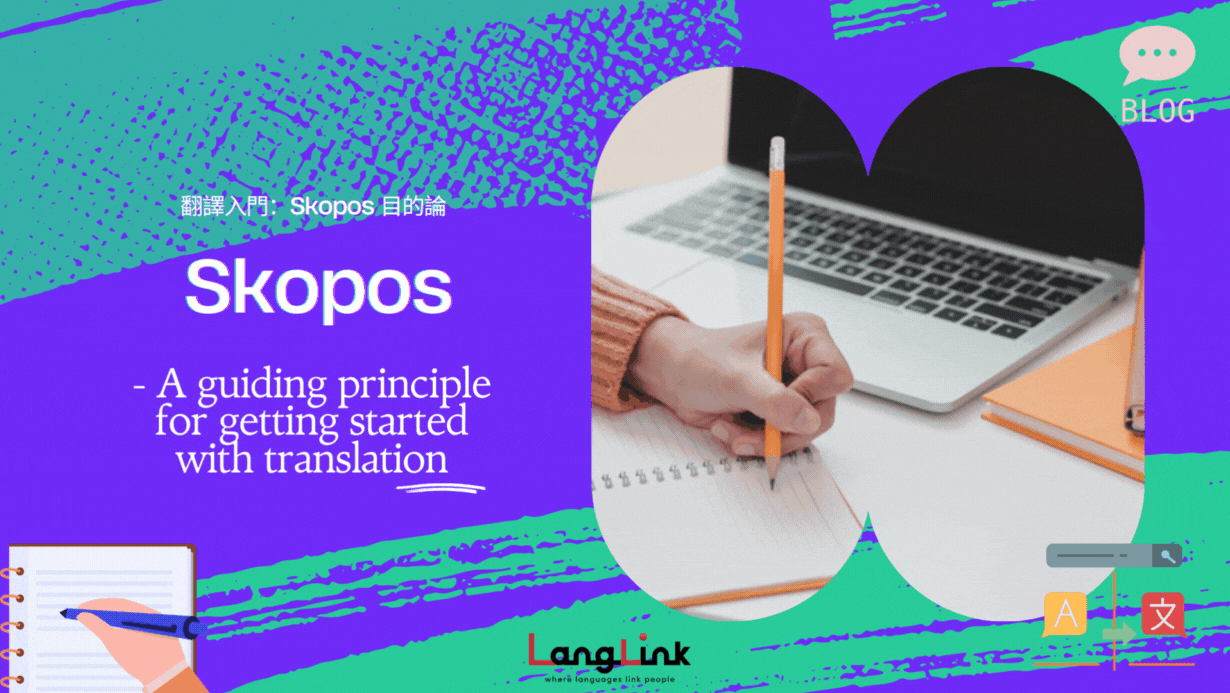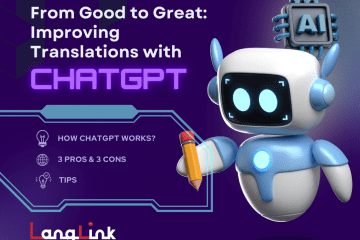Skopos - A guiding principle for getting started with translation
By LangLink HK Chloe

We know there are different approaches towards translation — liberal & literal translation and communicative & semantic translation to name a few. But which one should we actually adopt during live production? This was also the question that perplexed me while I was studying translation during my undergraduate years. Sometimes, I tried to use some creativity to provide a more engaging translation for literary texts, but I was told that my translation deviated from the source, so I adopted a more literal approach the next time and was told that the translation was too rigid by adhering too much to the source.
Really confusing.
That problem persisted until I learned about Skopos in a translation theories course. I used to think that translation theories were completely useless for practical translation. The most common theories we’ve heard of are usually about achieving equivalence (by Eugene Nida) or the notion of faithfulness, expressiveness, and elegance (信達雅) by Yanfu. It was impressive for translation scholars to propose such theories to set a benchmark for the emerging translation trend a hundred years ago. But nowadays, we all know that such standards are easier said than done. And different standards are required for different tasks. For example, we aim for faithfulness in legal texts but expressiveness in training documents. This is where Skopos may be of help.
Skopos argues that the end justifies the means. To put it simply, the target audience and the translation objective justify our approach to translation. That may explain why a single book is retranslated as the target audience and translation goals are different. Let’s take the well-known The Adventures of Sherlock Holmes as an example. The novel is translated into multiple Chinese versions. One of them is a bilingual version with the translation part done by Mei Shaowu and Tu Zhen. This version aims to help English learners improve their English proficiency through reading the book accompanied by the Chinese version to facilitate understanding. Another version is published by Oxford University Press and translated by Li Jiazhen, who mentioned that he enjoyed reading the original English version a lot and hoped to present that authentic source style to the target readers. The last one we are going to discuss is published by the Youfu editing team, a publisher that serves children. From their target audience and translation goals, we can deduce that Mei and Tu’s version aims to produce a fluent, understandable translation, while Li’s version hopes to be faithful to the source, and Youfu’s version would be kid-friendly.
Here are some examples of how their ends justify their means:
Source: He [Sherlock] disappeared into his bedroom and returned in a few minutes in the character of an amiable and simple-minded nonconformist clergyman.
Target (1) 他去臥室待了幾分鐘,出來的時候已經變成了一位和藹可親、思想單純的自由派牧師*。
*Footnote: 指不尊奉國教的英國新教牧師。英國國教是天主教與新教的混合體,以英國君主為最高領袖。當時的法律不允許假扮英國教會牧師,這可能是福爾摩斯選擇假扮自由派牧師的原因。
Target (2) 他進入臥室,過了數分鐘再出來時,已經喬裝改扮成一名純樸而和藹可親的新教牧師。
Target (3) 福爾摩斯又走進房間,過了幾分鐘,他出來了。這一次,他變成一個牧師。
Let’s focus on the translation of « nonconformist clergyman ». Both the first and second translations provided a literal translation of the term, but the first one also added a footnote explaining what « nonconformist » is and why Sherlock pretended to be a nonconformist clergyman. While the third version omitted the meaning of « nonconformist » and translated it into « clergyman ». It is clear that the first one is Li’s version as he aims to provide a faithful translation that reflects the 1900s. The second one is translated by Mei and Tu, who aim to provide a readable translation to facilitate understanding, while the third one is released by the children publisher as it’d be better to make the book as simple as possible for the sake of little readers.
Below is another example that depicts how the end justifies the means. Interestingly, the whole part is omitted in Youfu’s version, probably because it mentions the drug « cocaine ». As for Li VS Mei & Tu, they have adopted different approaches towards the word « Bohemian », with Li providing a literal translation and a footnote and Mei & Tu providing a liberal translation.
Source: … while Holmes, who loathed every form of society with his whole Bohemian soul, remained in our lodgings in Baker Street, buried among his old books, and alternating from week to week between cocaine and ambition, the drowsiness of the drug, and the fierce energy of his own keen nature.
Li: 反過來,福爾摩斯卻是個不折不扣的波希米亞人*,形形色色的社會規範都讓他厭憎不已。他繼續住在我們之前居住的貝克街寓所裏,一頭扎在他那些古舊書籍之中,這一個星期在可卡因的作用之下昏昏欲睡,下一個星期又雄心萬丈,爆發出警醒天性帶來的蓬勃活力,如此交替,周而復始。
*Footnote: 後文用來形容福爾摩斯的「波希米亞人」(Bohemian)並不是指波希米亞的居民,而是吉普賽人的別稱,象徵一種天馬行空、放任不羈、愛好文藝的生活方式,文學修辭和流行文化中的波希米亞通常都是這個意思。吉普賽人是從北印度移居歐洲的一個流浪民族,後被法國等地的歐洲人誤以為來自波希米亞,所以有此別稱。
Mei and Tu: 福爾摩斯則懷著他那豪放不羈的氣質,厭惡社交界的繁縟禮儀,依舊住在我們之前合租的百家街住所裏,整天埋頭於他的舊書堆裏,一週週地交替於這樣的狀態之間:時而用可卡因提提神,時而因毒品而引起瞌睡,時而又因自身天生的好體質而精力旺盛。
Youfu: The whole part is omitted.
Now we understand how we determine our translation approach based on our goal, let’s delve into how we identify our goal. The best tool would be translation briefs. We identify the source and target languages, the target audience, where the translation would be placed, the translation goal (or the target message), etc. in a translation brief. And such information is usually included in the style guides provided by clients. So always remember to study the style guide thoroughly!
For example, one of our clients is a leading music streaming service provider. They specifically pointed out that they want their translation to include some creative music elements and they welcome transcreation for marketing materials. So we always try to incorporate lyrics of songs by local artists in the translation whenever possible to make it more engaging and relatable for the target audience, just like the example below where 那故事倉猝結束 is indeed part of the song 念念不忘 by the local Hong Kong artist Juno Mak:
Source: We know things didn’t end too well between us, but we are still hoping for a second chance. Here is a little something that might rekindle the flame: 3 months for {0}.
Target: 我們知道,那故事倉猝結束 (back translation: We know the story [bewteen us] ends abruptly),但我們仍然希望有多一次機會。這是我們的小心意,希望與你再續前緣:3 個月服務只需 {0}。
Client comment: I think it’s a nice adaptation. Juno is well known enough across many HK audience group.
Another client mentioned the importance of simplicity in their SG. However, our team transcreated the source a bit:
Source: Going global is exciting and definitely possible.
Target: 邁向全球是一項令人期待的決策,並且絕對有可能做到。(Back translated as « Going global is an exciting decisino and definitely possible.)
And here’s what the reviewer commented: we focus translation accuracy and human speaking tone with simple sentencing to adapt local culture, NOT how to polish the translation… Our purpose is to let our customers read the communications straightforward. Meanwhile, the word 決策 (decision) is not found in EN source.
Even without SG, we can still determine the translation end by doing some research on the client. For example, we work with a leading theme park to help translate their online shop content. The client aims to provide a fancy, wonderful experience for all of their guests, be they children or adults. So we can deduce that the translation should be engaging and friendly.
Source: Your precious Princess will waltz into a world of pure fantasy wearing these shimmering ankle strap shoes with golden faux leather trims and faceted gem adornments, made to match perfectly with our costume collection.
Target: 這款童裝鞋採用繞踝繫帶設計,帶有金色仿皮飾邊和刻面寶石裝飾,閃耀動人,能夠完美配搭我們的公主造型服飾系列。快讓您可愛的小公主穿上它,蹦蹦跳跳地走進奇妙的夢想世界。
(Back translation: This pair of shoes adopts an ankle strap design with golden faux leather trims and faceted gem adornments. It is shimmering and can match perfectly with our costume collection. Let your precious Princess wear the shoes and waltz into a world of pure fantasy.)
It is a common approach to translate « with » into 採用 (adopt) in zhhk. However, given the fantasy tone of the client, this word may sound too rigid. Therefore, it’d be better to use more vivid word choices:
Revision: 讓你的小公主穿上這對閃耀動人的涼鞋,繫上腳踝處的綁帶,踏著輕快步伐走入奇妙的幻想世界吧!這款童裝鞋綴有金色仿皮飾邊和刻面寶石裝飾,完美搭配公主造型服飾系列。
(Back translation: Let your precious Princess wear this pair of shimmering sandals, fasten the strap at ankle, and waltz into a world of pure fantasy. This pair of children shoes is decorated with golden faux leather trims and faceted gem adornments and match perfectly with our costume collection.)
Let’s look at one more example. We work for a logistics company to translate their website into English. The following segment appears on their hero banner:
Source: 3亿人都在用它寄快递
Target: 300 million people are using XXX to send parcels
Although the translation can convey the message and look fine in terms of language, it is too dull and not engaging enough for a hero banner. Based on the placement, we can adapt the target as follows:
Revision: Trusted by 300 million users
To conclude, there is no one-size-fits-all solution for translation. We have to fine-tune our mindset depending on the client, the text type, the placement, etc. If you are still confused, the easiest way to get started is to provide a direct translation, i.e. avoid unnecessary addition and omission while maintaining fluency. And then you can try adjusting your translation approach to provide the most suitable translation for your clients.


